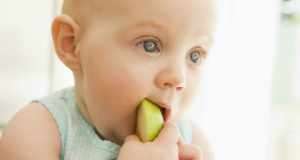
Babies are fuzzy eaters. However, you cannot feed them milk forever. You have to create a balanced diet. Solid food should not be a part of the diet of a child less than four months. Older toddlers, however, deserve some superfoods. Carefully select the list of fruits and vegetables, with a pediatrician’s help. Introduce these enriching and edible products gradually as they can replace milk in your baby’s diet.

Table of Contents
Bananas: top in the list of fruits and vegetables
Bananas are the most popular tropical fruits in the world. They come in a variety of sizes, shapes, and colors. The baby will relish eating this carbohydrate-rich fruit. It will also aid in digestion due to its rich fiber content.
Do not feed the child with raw, green bananas. Instead, wait for the fruit to become ripe and yellow. If your kid is too young, you can smash it with a spoon and mix it with rice cereals. If not, blend it with milk to make it a smoothie. Kids closer to one year can eat chopped bananas. Some parents try to add a dash of honey to the banana to make it more appealing. However, banana is already rich in sugar, and honey is not suitable for children less than one year. It could cause problems in the digestive system.
There are powdered banana or banana mash products in the market. Bananas are easier to find all around the world. Thus, it is best to avoid those preservative-filled packages and opt for the natural ones.
Sweet potatoes: natural and tasty
The sweet potato is a large and starchy root vegetable. No list of fruits and vegetables for kids is complete without it. This sweet vegetable is tasty, and you can boil, bake, fry, or steam this potato. Cook and mash the vegetable to make a delicious, smooth puree for the kids to find it easier to eat.

The sweet potato provides fiber, vitamin C, and potassium. Besides, it has beta-carotene and antioxidants to remove harmful free radicals. Sweet potatoes are suitable for kids above the age of 6 months. While picking sweet potatoes, choose the ones that are firm and have no cracks or soft spots.
Avocado – nutrient dense food
Avocado is suitable for kids above four months. It has a mild and creamy flavor, which might not be your baby’s favorite. Please do not over-feed avocado. A kid less than six months needs just 2 -4 tablespoons of avocado. By the time your baby is nine months old, you can add eight tablespoons. Avocado adds vitamin C, K, E, and B to the plate. Moreover, it is rich in minerals like manganese and zinc. Avocado, sweet potato, and banana are the three superfoods for constipation.
Carrots: a favorite in the list of fruits and vegetables
Carrots are an all-time favorite food for any age group. Kids, in particular, relish the crunchy feel and taste. The carrot is also a rich source of nutrients like beta carotene, potassium, vitamin K1, antioxidants, and fiber. They assist in the baby’s growth and also improve the quality of eyesight.

These naturally sweet roots also have a very appealing look and feel. Babies will enjoy eating the sweet and soft puree. Make sure you dice the carrots and cook well till they become very tender. You can introduce carrot puree at six months. If your kid is more than ten months old, you can slice baby carrots as finger food.
Broccoli: most hated and nutritious in the list of vegetables
There are several vegetables that a baby would love to eat. But the list of fruits and vegetables is incomplete without the most-hated vegetable, broccoli. It is a superfood with abundant amounts of fiber, potassium, and iron. The vegetable also provides folic acid, vitamin C, and beta carotene. But you have to cook it well.
Boiling broccoli in water would remove most of its nutrients. Instead, microwave or steam it with a dash of salt. Serve with butternut squash and sweet potatoes as a puree if the baby is reluctant to eat.
Nutritious peas: must-have in the list of fruits and vegetables
The green and yellow peas are bursting with rich nutrients. They are an excellent source of proteins and antioxidants. Besides, their vitamin K content works well with calcium to build bone strength. The food also has folic acid and vitamins A, B, and C. They also give a boost to the immune system.
Feed the kids who are older than six months with some delicious pea puree. You can also add some potato puree to add a good taste and texture. The peas are a pleasant way of introducing babies to solid food at a very young age.
Apple – the easy choice in the list of fruits

Apples can be a part of your baby’s diet as early as four months. Peel the apple and steam it to make a puree for your toddler. Once your baby is old enough to bite and chew, you can give thinly diced apples. As your kid gets used to the texture, you can stop steaming it before blending. Apple is a good source of fiber, folate, vitamin A, potassium, magnesium, calcium, phosphorous, vitamin K, and antioxidants. It is also helpful in improving brain health.
Watermelon – a simple addition to your baby’s diet
Watermelons can be a part of your baby’s diet from six months. Although watermelons are not rich in nutrients, they offer Vitamin C, A, and B5. Remember to remove the rind and seeds before providing them to your child. Chop the watermelon into thin rectangular slices to make it easy for the baby to pick it up and bite. Please avoid the rind, as it can cause choking.
Apart from these, you can add cucumber, pineapple, pear, peaches, squash, and others. It is important to remember that it is best not to add sugar to your baby’s food.

















